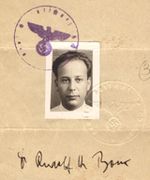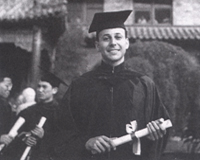 Rudolf H. Bock, MD (1915-2006) was a medical student in Vienna when Germany annexed Austria in 1938. Germany’s Nuremburg Laws were immediately applied to Austria, stripping all Jews of their citizenship. Although raised a Catholic, Bock’s grandparents were Jewish and in November he received word that he would not be able to finish medical school – he was 4 exams short of earning his medical degree.
Rudolf H. Bock, MD (1915-2006) was a medical student in Vienna when Germany annexed Austria in 1938. Germany’s Nuremburg Laws were immediately applied to Austria, stripping all Jews of their citizenship. Although raised a Catholic, Bock’s grandparents were Jewish and in November he received word that he would not be able to finish medical school – he was 4 exams short of earning his medical degree.
One month later, after the arrest of several family members, Rudolf Bock’s uncle was able to provide him and his brother with phony work papers which allowed them to enter Japan as refugees. Once in Japan Dr. Bock sought medical schools where he might finish his degree, but met resistance.
Bock had great hope in an American run school in Peking, China named the Peiping Union Medical College (PUMC), however his initial application was denied because he did not know Mandarin, Chinese. In a follow up letter Dr. Bock wrote, “I humbly beg your pardon for applying to you once more. I entreat you to look at the matter chiefly from a human point of view which is to help people in distress - nowadays more than ever. The admission to PUMC actually would be the only chance for my whole future.”
 Dr. Peter Kronfeld, a visiting professor in ophthalmology, read this plea and intervened on Dr. Bock’s behalf. In January 1939 Bock was accepted to PUMC on the condition that he would learn Chinese in order take the necessary oral exams. Bock immediately left his brother in Japan in order to finish his studies. Just over one year later Dr. Bock’s efforts were rewarded - he had earned his medical degree and had begun his residency in ophthalmology.
Dr. Peter Kronfeld, a visiting professor in ophthalmology, read this plea and intervened on Dr. Bock’s behalf. In January 1939 Bock was accepted to PUMC on the condition that he would learn Chinese in order take the necessary oral exams. Bock immediately left his brother in Japan in order to finish his studies. Just over one year later Dr. Bock’s efforts were rewarded - he had earned his medical degree and had begun his residency in ophthalmology.
Although Japan had been struggling with China since 1931, a systematic attack began in 1937 which made communication between Dr. Bock and his family in Japan nearly impossible. After the bombing of Pearl Harbor in December 1941, the Japanese army moved in and closed the doors of PUMC and its hospital. This action forced Dr. Bock to work in charity eye clinics and create a small ophthalmic practice in order to support himself and his wife. Having no official citizenship, Dr. Bock was essentially in hiding during the remainder of the war. It was not until afterward that he finally learned of the fate of his family members who had not escaped Austria. Many, including his father, had died in the Holocaust.
In 1947 Dr. Bock, his wife and children were allowed to return to Europe. Because his ophthalmic training was technically incomplete, he decided to move back to Vienna. There he repeated his exams for an Austrian medical degree and trained formally in ophthalmology. During this time, he started to apply for a visa to immigrate to the United States, which was finally granted in 1951. Dr. Bock eventually settled in California and opened a private ophthalmic practice.